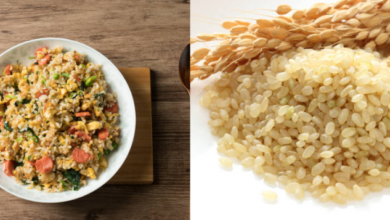Unveiled: the surprising truth about fried rice and your digestive health
What To Know
- Traditional fried rice recipes use white rice, which is a refined grain that has been stripped of its outer layers, including the bran and germ, where most of the fiber is concentrated.
- Yes, brown rice fried rice is healthier than white rice fried rice because brown rice contains significantly more fiber, vitamins, and minerals.
- You can add fiber to fried rice by using brown rice or whole wheat rice, incorporating chopped vegetables, adding beans or lentils, or topping with fiber-rich sauces.
Fried rice, a culinary staple relished worldwide, often raises questions about its nutritional value, particularly regarding its fiber content. Many health-conscious individuals wonder, “Is fried rice low fiber?” This blog post aims to delve into the answer to this question, exploring the fiber content of fried rice, its impact on overall health, and providing practical tips for incorporating more fiber into this beloved dish.
Fiber: The Indispensable Nutrient
Fiber, a type of carbohydrate that the human body cannot digest, plays a crucial role in maintaining good health. It aids in digestion, helps regulate blood sugar levels, and promotes a feeling of fullness, contributing to weight management. Adequate fiber intake is associated with a reduced risk of chronic diseases such as heart disease, stroke, and type 2 diabetes.
Fried Rice and Fiber
Traditional fried rice recipes use white rice, which is a refined grain that has been stripped of its outer layers, including the bran and germ, where most of the fiber is concentrated. As a result, white rice is relatively low in fiber, typically providing around 0.6 grams per cooked cup.
The Impact of Cooking Methods
The cooking method also influences the fiber content of fried rice. Stir-frying, a common technique used to prepare fried rice, involves cooking rice in a small amount of oil over high heat. This process does not significantly alter the fiber content of the rice, as the heat does not destroy the fiber.
Enhancing Fiber Content
While traditional fried rice may be low in fiber, there are several ways to enhance its fiber content without compromising its taste or texture. Here are some practical tips:
1. Use Brown Rice or Whole Wheat Rice
Brown rice and whole wheat rice are whole grains that retain their bran and germ, making them significantly higher in fiber than white rice. Substituting white rice with brown or whole wheat rice can dramatically increase the fiber content of fried rice.
2. Add Vegetables
Vegetables are excellent sources of fiber. Incorporating chopped vegetables such as broccoli, carrots, bell peppers, or mushrooms into fried rice adds flavor, nutrients, and fiber.
3. Include Beans or Lentils
Beans and lentils are legumes that are packed with fiber. Adding a handful of cooked beans or lentils to fried rice can significantly boost its fiber content.
4. Top with Fiber-Rich Sauces
Sauces can also contribute to the fiber content of fried rice. Choose sauces made with whole grains, vegetables, or beans to add extra fiber to your dish.
Benefits of Fiber-Rich Fried Rice
Incorporating more fiber into fried rice offers numerous health benefits:
1. Improved Digestion
Fiber promotes regular bowel movements, preventing constipation and other digestive issues.
2. Blood Sugar Control
Fiber helps slow down the absorption of sugar into the bloodstream, preventing spikes in blood sugar levels.
3. Weight Management
Fiber keeps you feeling full for longer, reducing calorie intake and supporting weight management efforts.
4. Reduced Disease Risk
Studies have shown that adequate fiber intake is associated with a lower risk of chronic diseases such as heart disease, stroke, and type 2 diabetes.
Recommendations: Making Fried Rice a Fiber-Rich Feast
Fried rice, a beloved culinary staple, can be transformed into a fiber-rich dish by incorporating brown rice, vegetables, beans, or lentils. By making these simple modifications, you can enjoy the delicious flavors of fried rice while reaping the numerous health benefits of fiber. So, next time you crave fried rice, embrace these fiber-boosting tips to create a nutritious and satisfying meal.
Questions We Hear a Lot
1. How many grams of fiber are in a cup of fried rice?
The fiber content of fried rice varies depending on the ingredients and cooking method. Traditional fried rice made with white rice typically contains around 0.6 grams of fiber per cooked cup.
2. Is brown rice fried rice healthier than white rice fried rice?
Yes, brown rice fried rice is healthier than white rice fried rice because brown rice contains significantly more fiber, vitamins, and minerals.
3. What are some ways to add fiber to fried rice?
You can add fiber to fried rice by using brown rice or whole wheat rice, incorporating chopped vegetables, adding beans or lentils, or topping with fiber-rich sauces.

